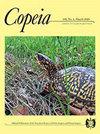捕食者诱导安氏小蝌蚪形态变化
IF 2.6
Q2 Agricultural and Biological Sciences
引用次数: 5
摘要
捕食者可以通过多种方式影响被捕食物种的发育、健康和行为。为了应对捕食的威胁,蝌蚪可以改变生长速度、形态和觅食行为。蝌蚪发育的变化有可能改变其生活史特征,因此引起了人们对保护物种的兴趣。利用实验性中尺度,我们探索了非致命捕食者如何影响美国近危物种松Barrens Treefrog的幼虫发育。我们发现,笼中蜻蜓(Anax junius)会使安氏蝌蚪的尾巴颜色更深,尾鳍更深,但蜻蜓不会影响蝌蚪的行为、生存或变形时的大小。与没有捕食者的种群相比,非致命捕食者的存在也导致了种群内部尾巴颜色特征的更大变化。这一结果表明,表达表型可塑性性状的能力可能存在潜在的遗传变异,这一概念应该进一步探索,因为它对诱导型防御的进化有影响。这些发现支持了类人猿蝌蚪中存在一种适应性综合征,即蝌蚪在对蜻蜓幼虫捕食者的反应中形成明显的尾巴形态。本文章由计算机程序翻译,如有差异,请以英文原文为准。
Predators Induce Morphological Changes in Tadpoles of Hyla andersonii
Predators can affect the development, fitness, and behavior of prey species in myriad ways. In response to the threat of predation, tadpoles can alter growth rate, morphology, and foraging behavior. Changes to tadpole development have the potential to alter life history characteristics and are therefore of interest in species of conservation concern. Using experimental mesocosms, we explored how non-lethal predators affected the larval development of the Pine Barrens Treefrog, Hyla andersonii, a near-threatened species in the United States. We found that caged dragonflies (Anax junius) induced darker tail coloration and deeper tail fins in tadpoles of H. andersonii, but the dragonflies did not affect tadpole behavior, survival, or size at metamorphosis. Non-lethal predator presence also induced greater within population variation in the tail color trait compared to populations without predators. This result suggests that there may be underlying genetic variation in the ability to express phenotypically plastic traits, a concept that should be explored further because it has implications for the evolution of inducible defenses. These findings support the existence of an adaptive syndrome among hylid tadpoles, where tadpoles develop conspicuous tail morphology in response to larval dragonfly predators.
求助全文
通过发布文献求助,成功后即可免费获取论文全文。
去求助
来源期刊

Copeia
生物-动物学
CiteScore
2.10
自引率
0.00%
发文量
0
审稿时长
6-12 weeks
期刊介绍:
Founded in 1913, Copeia is a highly respected international journal dedicated to the publication of high quality, original research papers on the behavior, conservation, ecology, genetics, morphology, evolution, physiology, systematics and taxonomy of extant and extinct fishes, amphibians, and reptiles. Copeia is published electronically and is available through BioOne. Articles are published online first, and print issues appear four times per year. In addition to research articles, Copeia publishes invited review papers, book reviews, and compiles virtual issues on topics of interest drawn from papers previously published in the journal.
 求助内容:
求助内容: 应助结果提醒方式:
应助结果提醒方式:


